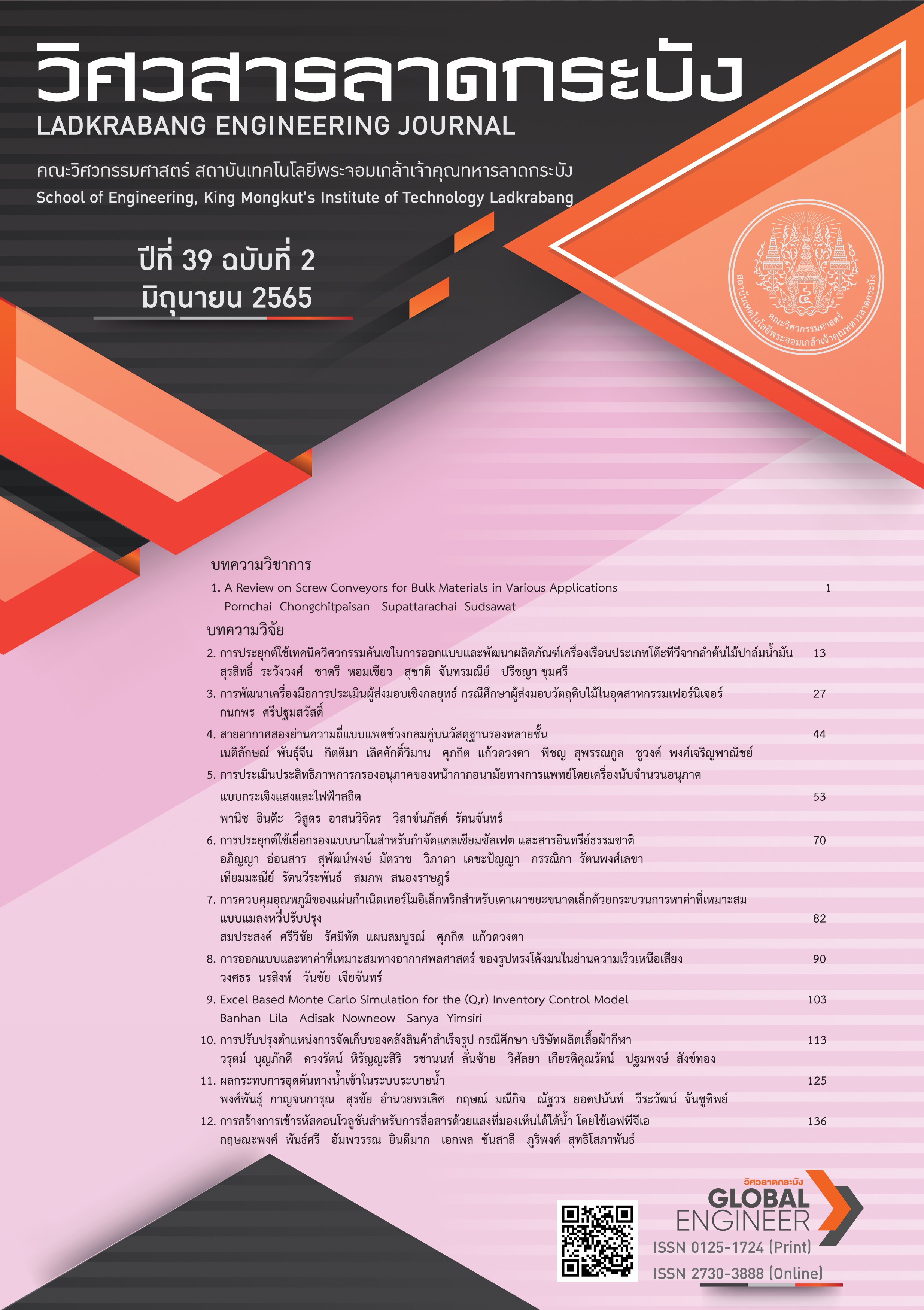Improvement of the Storage Locations for the Finished Products Warehouse: A Case Study of Sportswear Manufacturing Company
Keywords:
Fast mover closest to the door method, ABC analysis, Binary integer linear programing, Inventory turnoverAbstract
This study presents the improvement of the storage location for the finished goods warehouse in sportswear manufacturing. The objective is to increase the efficiency of finished goods storage in more operational work. In the current condition, the warehouse has stored finished goods at the non-fixed location explicitly, causing them to take long time for moving to the storage location. Therefore, the authors determined the locations for storing the products. ABC analysis with the concept of grouping analysis theory was applied to organize into groups of goods from its movement. In addition, MATLAB, software for computing the storage location on the principle of the binary integer linear program, was enhanced to determine the location for storing products appropriately by considering the moving time significantly. As a result of the study, the storage improvement by the new storage location enhances to diminish the overall storage time of the classified group A and B to 16.12 % and 11.55%, respectively. Classified group C has an average moving time of 23.71 seconds per one shelf.
References
S. Rattanaboworm and T. Phannikul, “Use of Engineering Economics in increasing storage capability,” UBU Engineering Journal, vol. 8, no. 2, pp. 48–61, 2017.
N. Punthanakoraphat and C. Mongkalig, “Improvement of an Agricultural Products Packaging Warehouse,” Industrial Technology Lampang Rajabhat University Journal, vol. 9, no. 1, p.22–32, 2016.
S. Yoonan, “The Layout Design to Finished Good in Warehouse by Using ABC Analysis Case Study Precast Concrete wall panel,” M.S. Independent Study, Dept. Logistics and supply chain, Sripatum University, Bangkok, Thailand, 2017. [Online]. Available: http://dspace.spu.ac.th/handle/123456789/5672.
W. Cuhanpet, “The Layout Design of Finished Goods in Warehouse by ABC Analysis Case Study of AAA Company Limited,” M.S. Independent Study, Dept. Logistics and supply chain, Sripatum University, Bangkok, Thailand, 2019. [Online]. Available: http://dspace.spu.ac.th/handle/123456789/5863.
R. Sinthavalai, T. Touwato and A. Hayeeteh, “Efficiency Improvement in the Inventory Based on DMAIC Methodology,” Naresuan University Journals, vol. 26, no. 2, pp. 96–109, 2018.
S. Creawan, “Improving a Finished Goods Warehouse Layout by Fast-Slow Moving A Case Study of Creachareon Machinery Co.,Ltd.,” M.S. Independent Study, Dept. Logistics and supply chain, Sripatum University, Bangkok, Thailand, 2019. [Online]. Available: https://shorturl.asia/QdeDg
A. Jitsoonthornchaiku, “Improving Efficiency in Inventory and Warehouse Operations in Thailand’s Break Pads Industry:A Case Study of S.C.H. Industry Co.,Ltd.,” Suthiparithat Journal, vol. 32, no. 102, pp. 45–57, 2018. [Online]. Available: https://so05.tcithaijo.org/index.php/DPUSuthiparithatJournal/article/view/243405/165182.
N. Chayayam, “ABC Analysis,” sc2.kku.ac.th. http://sc2.kku.ac.th/stat/statweb/images/Eventpic/60/Seminar/02_15_.pdf. (Accessed: Nov. 14, 2021)
C. Anurattananon, P. Klomjit, T. Chuenyindee and P. Songsuktawan. “Efficiency Improvement of Drinking Warehouse Case Study of Sample Drinking Company,” Thai Industrial Engineering Network Journal, vol.5, no.1, pp. 49–58, 2019.
Inventory Management with ABC analyser, Warut Boonphakdee, 2019. [Online]. Available: https://www.mathworks.com/matlabcentral/fileexchange/72939-inventory-management–with-abc-analyser, MATLAB Central FileExchange
Downloads
Published
How to Cite
Issue
Section
License
Copyright (c) 2022 Faculty of Engineering, King Mongkut’s Institute of Technology Ladkrabang

This work is licensed under a Creative Commons Attribution-NonCommercial-NoDerivatives 4.0 International License.
The published articles are copyrighted by the School of Engineering, King Mongkut's Institute of Technology Ladkrabang.
The statements contained in each article in this academic journal are the personal opinions of each author and are not related to King Mongkut's Institute of Technology Ladkrabang and other faculty members in the institute.
Responsibility for all elements of each article belongs to each author; If there are any mistakes, each author is solely responsible for his own articles.






